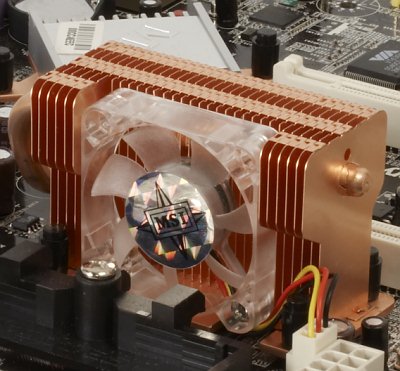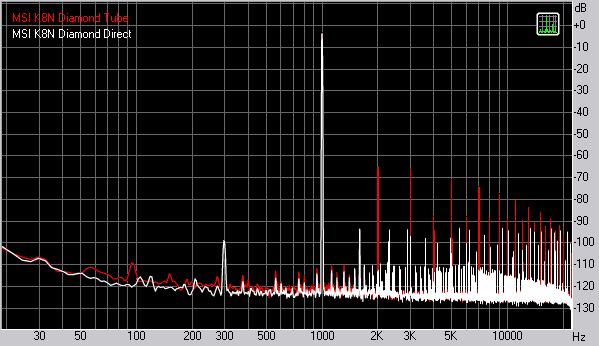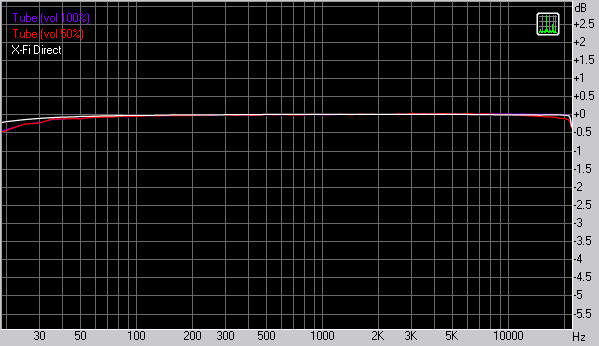 |
||
|
||
| ||
As is well known, manufacturers get more profits from selling ten elite motherboards than a hundred mass-production models. That's why manufacturers, at least from top five companies, never miss the opportunity to offer products based on top chipsets, they spare no effort to design original products. This time MSI was even a tad late compared to its nearest competitor, despite its famous strategic partnership with NVIDIA. Let's not delay the introduction. MSI continues equipping top motherboards with an audio system from Creative. For example, MSI P4N Diamond had a built-in Creative Sound Blaster Live! 24-bit. The model under review is equipped with an audio controller, based on Sound Blaster Audigy SE. Cognominal Audigy SE card is an exact copy of the Live! 24-bit. (The old product bears a new name probably for marketing reasons.) Launched as a budget solution, Live! 24-bit turned out quite successful. It's no worse than Audigy cards in its functions (7.1 audio format, 24 bit 96 kHz, high-quality software support for 3D audio in games and EAX 3.0 extensions). DAC from Audigy2 makes it even better in audio quality than the first Audigy model. That's why raising the status of the card to Audigy SE looks natural. In case of the MSI K8N Diamond Plus, this trademark is fully justified — the board has the same CA0106DAT processor and the same converters (ADC — Wolfson WM8775, DAC — Cirrus Logic CS4382) as on stand-alone Audigy SE/Live! 24-bit cards.  A unique feature of this motherboard is a separate tube filter with a volume unit meter (VU meter) that offers volume control, a headphones jack, and a volume needle indicator. VU meter is a device that shows the average (not peak) audio signal level. It's intended to provide an approximate idea of the subjective volume level. In this case it's obeisance to the tube architecture, its indispensable attribute in old times. The tube unit is implemented as a panel to be installed into a 5-inch bay. Along with aesthetics reasons, this solution facilitates access to the headphones jack and the volume control. This is a stand-alone unit, which can be connected with bundled cables to the integrated Audigy SE as well as to any other sound card.  The K8N Diamond Plus layout is just as good as in the previous top motherboard K8N Diamond SLI (on "regular" nForce4 SLI) — despite relatively many additional controllers, we have no gripes with the location of ports and jumpers. Only the additional power connector slightly spoils the impression: an inductance coil near this connector hampers opening the latch. Both bridges of the chipset are cooled by a single system of two heatsinks, connected with a heat pipe. Even though we used water cooling for CPU, a fan on the heatsink rotated at medium speed in the course of all tests. If you use a powerful cooler of a traditional design that can cool components around the processor, you may remove the chipset fan. If you want to achieve the lowest noise level, of course (and if you don't want to break any overclocking records!). Design of the heatsink distinctly hints at this possibility.  We have only one wish concerning the expansion ports: it would have been perfect to have one more PCI slot - we could have easily sacrificed a currently useless PCI Express x1 for it. By the way, it should be noted that indifference of expansion card manufacturers to the two-year-old new peripheral interface can be explained not only by their inert nature, but also by quite real disadvantages of the interface itself, a higher latency versus PCI in the first place. Thus, in cases when throughput is not a bottleneck, upgrade to PCI Express maybe not only useless, but even harmful. This particularly concerns curtailed modifications (for example, x1). We already wrote about the prospects of upgrading [professional] sound cards to the express bus. The three-phase switching voltage regulator incorporates four field-effect transistors per channel, seven 4000 uF capacitors of the SEPC series from Sanyo. There are also four 1000 uF capacitors and several ones of a lesser capacitance of the KZG series from United Chemi-Con. On the whole, the choice is very good. Sanyo capacitors took root in top MSI motherboards, offering high capacitance at surprisingly small dimensions due to using solid [partially] conducting polymer for dielectric instead of electrolyte. Common bonus for the SEP series — stability in extreme operating conditions (for example, the guaranteed service life at maximum temperature of 105°С is 3000 hours). The SEPC series adds Low ESR, which is important in this case for reducing capacitance heating in the first place. It's overheating that results in gradual deterioration of capacitor's characteristics in regular conditions under maximum load. The board contains a 8-pin power connector for a processor of the server standard EPS12V (4 pins +12 V). But in case of our configuration, the motherboard was stable even when powered from the popular 4-pin connector ATX12V. The manual specifies a requirement to the current at this power connector — not less than 18 A. There is also a standard 4-pin peripheral connector for very powerful video cards in PCI Express x16 slots. There are no empty seats on the motherboard — MSI product range currently includes only one motherboard on nForce4 SLI X16, its design is unique. Motherboard dimensions — standard ATX (305×245 mm), nine-screw mount, all corners are firmly fixed. Top status of this model is set by the on-board sterling Creative Sound Blaster Audigy SE (AKA Sound Blaster Live! 24-bit). Cooling system for a chipset with heat pipes allows to do without an extra fan (under certain conditions), which is another advantage of the motherboard. And finally, let me enumerate a number of useful trifles such as a CMOS Reset button (not a jumper), PCI slot with a dedicated power line, a lot of field-effect transistors in the CPU power regulator (so that you may even do without passive cooling for this unit) — the Original Design award is well deserved by the MSI K8N Diamond Plus.  System monitoring (Winbond W83627EHF, according to BIOS Setup)
Onboard ports, sockets, and connectors
Back panel (left to right, blockwise)
Click to open the 3/4 back view
Package Contents

Click the image to see the PCB of the tube unit
The set of proprietary MSI utilities includes:
The tube panel with VU meter, offered in the standard bundle, will certainly attract attention. In fact, it may be so attractive that the high price for this motherboard will stop being a deterrent. It's very convenient that the tube audio filter can work with any other audio section, that is it's a stand-alone unit, which is often not the case with bonuses for top motherboards. It's somehow awkward to mention in the next sentence about "hackneyed" D-LED, rich set of cables and rear panel brackets, and other trifles - but all together they back up our decision to award the MSI K8N Diamond Plus for its excellent bundle.  Integrated Controllers
The integrated audio quality was tested in 16 bit, 44 kHz using the RightMark Audio Analyzer 5.5 test application and the Terratec DMX 6fire sound card in two modes — with the tube panel and without it
Let's have a look at the spectrum in the harmonic distortion test. The tube filter enriched the signal with harmonics, both even and odd. Odd harmonics in the signal from the integrated audio output can be explained by resampling 44 kHz into 48 kHz. You'd better use software 48 kHz resampling plugins to listen to music.  To evaluate the tube filter, we took additional readings with a high-quality X-Fi Elite Pro card with top converters (114 dB signal/noise in loopback) and no resampling problems.  We took readings at 50% and 100% of VU meter on the tube panel. We can see the same spectrum here even with lower amplitude. In other words, harmonics are generated by the tube panel itself, they do not appear due to overload. Comparing the results with X-Fi under the same conditions, we can say we should praise the tube panel alone for the entire spectrum. Another moment: heavy reduction of channel crosstalk is probably the effect of circuitry. We have no gripes with the frequency response — the entire spectrum of frequencies is reproduced without roll-off.  We have listened to the effect of the tube panel on active speakers JetBalance JB-381. The first thing you notice is strong tone changes. If the engineers tried to bring significant differences to audio quality, they apparently achieved the desired effect. The second peculiarity is worse stereo panorama and detailing. Against a background of sound degradation, we can make out some subjective softening of the attack and high-frequency sharpness — perhaps that was the idea, to use the tube filter for low-bitrate MP3 records? Some people may like the sound, but we would have preferred a tube filter offering more even harmonics of a limited number (it's hard to explain 20 harmonics of a large amplitude). Perhaps the manufacturer should think about adding the Tube/Direct toggle for those who want to listen to music through the tube unit as well as directly (avoiding manual switching). Tests of the headphones-out on the tube panel with Sennheiser HD600 demonstrate that the amplifier provides a necessary comfortable volume level, but possesses no power reserve. Readings for the headphones-out without a load match those for the line-out. Proprietary technologies and peculiarities
Settings
We used BIOS 1.12 dated 22.12.05, the latest available BIOS version at the time of our tests. The mentioned BIOS parameters are available in this version, but the viability of non-standard settings hasn't been tested. A separate mention should be made of rare settings for Scrub parameters for ECC memory. Besides, MSI made a present to hardcore overclockers - they can overclock memory to very high values, but to unlock additional values you should replace the corresponding jumper. PerformanceTestbed configurations:
We compared our model under review with the previously examined ASUS motherboard on the same chipset.
Spoiled by the integrated memory controller in AMD K8 processors, when we find such differences in the results (maximal in archivers, which are sensitive to memory nuances, decreasing towards media encoding tasks, and zeroish in games), we look for errors in the measurement procedure. In particular, we make sure we didn't forget some parameter set to 2T. No, everything is correct. Thus, the results permit us to draw a conclusion that the MSI model [for some reason] works with memory a tad slower than the ASUS model. But to all appearances, the formal lag of the MSI K8N Diamond Plus from its direct competitor in games (the main profile for such motherboards) is also the effect of memory operation differences, we detected no differences between the graphics interfaces. Bottom lineSuch insignificant performance differences will hardly affect the overall positive impression of this motherboard. MSI did a good job to make a High-End board. We should mention the original dynamic overclocking technology, which controls not only a processor, but also system parameters. The expert design of the model and its interesting bundle allow us to recommend it to all enthusiasts, who will also get a tiny bonus from the sterling SLI x16 in games. The only serious disadvantage is the price, which is nearly $100 as high (at the time this article was written) as that for the expensive MSI K8N Diamond (on NVIDIA nForce4 SLI, with the same integrated audio). What concerns a tube in the audio section, we should point out a difference from the pioneer among tube motherboards — AOpen AX4B-533 Tube. In this AOpen model, the tube was integrated into the motherboard. But the MSI motherboard has the tube unit connected to standard outputs at the rear panel and this unit is not a mandatory component. Moreover, it can be used with any other motherboard and sound card. Our tests show that the tube panel changes the audio quality much, but it does not follow the concept of the tube audio in the traditional sense — the harmonic spectrum does not improve the audio quality subjectively. Perhaps, this design acts just as a decoration. We can only congratulate the manufacturer with this original concept and wish to perfect it in future models.
The motherboard is kindly provided by the manufacturer
Write a comment below. No registration needed!
|
Platform · Video · Multimedia · Mobile · Other || About us & Privacy policy · Twitter · Facebook Copyright © Byrds Research & Publishing, Ltd., 1997–2011. All rights reserved. | |||||||||||||||||||||||||||||||||||||||||||||||||||||||||||||||||||||||||||||||||||||||||||||||||||||||||||||||||||||||||||||||||||||||||||||||||||||||